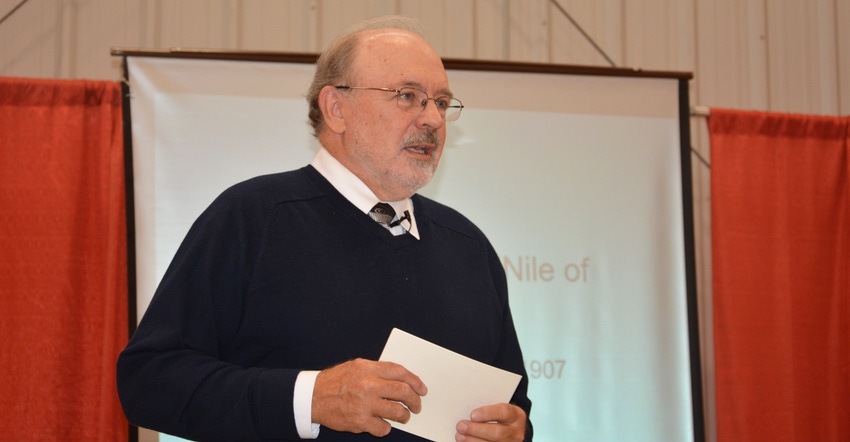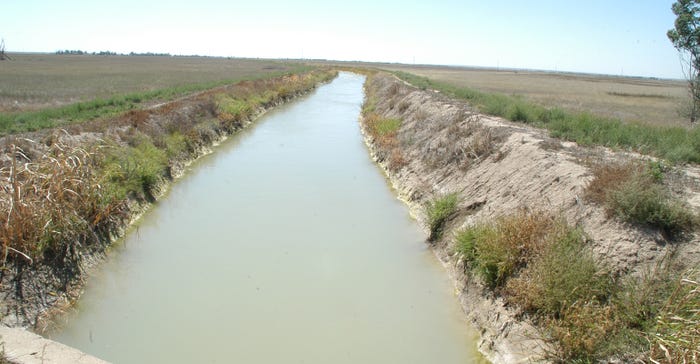
The framework for water regulation in the western United States has its origin in a 1907 Supreme Court case: Kansas v. Colorado.
While many Kansans are familiar with the long-standing dispute that eventually resulted in not one, but two, Supreme Court cases, many are less familiar with how the original battle created the Interstate Water Compacts that form the structure of water regulation in the western United States.
James Sherow, a Kansas State University professor, shared history and stories of the colorful and famous people who participated in making it happen with visitors to this year’s 3i Show in Dodge City, Kan.
Among them was Marshall Murdock, founder of the Wichita (Kan.) Eagle and proponent of creating an “inland port” in the city. Renowned in part for his dramatic terminology, including naming Wichita the “peerless princess of the Plains,” Murdock referred to the battle between Colorado and Kansas over the Arkansas River as a “contest for the Nile of America.”
The fundamental clash came about as a result of the market culture unique to the founding fathers of the United States, along with basic differences in how Colorado and Kansas lawmakers viewed water rights.
The American economic system is built on a presumption that natural resources are provided for the use of man to create economic value. Trees are seen as lumber, water is seen as irrigation for crops or hydropower for generating electricity, minerals are the building blocks for beneficial products. It is, in the market system, the role of government to protect the rights of citizens to use those natural resources to the greatest benefit.

DITCH SYSTEM: The system of ditches to divert water from the Arkansas River into canals that farmers in Kearny and Finney counties in Kansas can use for irrigation was created in the late 1800s, and it is still in use.

Prior appropriation vs. riparian doctrine
Colorado’s constitution provided for prior appropriation of water rights — essentially first in time, first in right — and held that as long as water was being put to beneficial use, there was no limit to how much could be used. Kansas, however, supported the riparian doctrine, which held that one state could not legally impair the quality or the quantity of water naturally flowing across its border into another state.
“Needless to say, if the riparian doctrine were to prevail, the ability of Colorado farmers to irrigate cropland would be severely curtailed,” Sherow said. “By 1900, there were nearly 100 irrigation systems in place, watering 300,000 acres between Pueblo, Colo., and the Kansas state line.”
In addition, the Colorado Fuel and Iron plant relied on Arkansas River water. The company employed 16,000 workers in Colorado.
Another player was the U.S. government’s Reclamation Service (now known as the U.S. Bureau of Reclamation), which wanted to build dams to impound water to use for the generation of hydroelectric power.
Western Kansas also had flood irrigation systems and a profitable crop in sugarbeets; initially, Murdock blamed the region for the lack of water in the Arkansas River in Wichita. When he learned that Kansas had only a fraction of the irrigation as Colorado, he decided maybe Colorado was to blame for the low flows.
When Murdock’s son, Victor, was elected to the state Legislature, he became a leader in the effort to initiate a Kansas lawsuit against Colorado.
In 1901, A.A. Goddard, the Kansas attorney general, filed a lawsuit insisting that Kansas’s riparian doctrine should hold sway over Colorado’s rule of prior appropriation. Colorado Attorney General Charles C. Post countered that Kansas could not make a claim on water from the Arkansas because it was not navigable, and the Colorado state engineer argued that every drop of water flowing out of Colorado into Kansas represented an economic loss.
The Colorado Fuel and Oil Co., owned by the Rockefeller family, and the Ark Valley Ditch Owners joined forces to hire lawyers to fight for their interests, and the Bureau of Reclamation petitioned for the federal government to assert first rights to interstate waters.
The court master collected 9,600 pages of transcripts, interviewing landowners, farmers and town officials from the southernmost point of the river in Kansas at Arkansas City, all the way to Pueblo, (Colo.), Sherow said.
Dilemma for farmers in Kearny, Finney counties
The parties most concerned were the farmers in Kearny and Finney counties, who saw themselves losing either way the suit went. If Colorado won, the saw their available water supply becoming less and less. If Kansas won and insisted on preserving flows to Wichita, they would be forced to end irrigation.
In the end, Sherow said, the job of writing the court’s opinion fell to Justice David Brewer, who was a Kansan, and the only member of the court familiar with irrigation issues.
The decision hinged on being able to show that Colorado’s use of water was causing economic harm to farmers in Kansas. However, the interviews with farmers showed a steady growth in the Kansas agricultural industry. What Brewer decided on was the creation of the Doctrine of Equity and the creation of Interstate Water Compacts, which were made up of members from each of the dissenting states. Their job was to agree to a fair division of water.
Interstate compacts became the structure of water regulation all across the western U.S., but they have by no measure solved the battles over water. By the mid-1980s, Kansas and Colorado were back at the Supreme Court. When that case was eventually decided in 2001, the Supreme Court agreed that Colorado “owed” water to Kansas, and a system of allowing Kansas to “call” for a release of water from the John Martin Dam until its share of water is delivered was set up.
The problem in recent years has been that in times of drought, the levels of the reservoir fall below the conservation pool, and no releases can be allowed.
“The reality is that water is still a contentious commodity,” Sherow said. “Long ago, the famous writer and philosopher Mark Twain said ‘Whiskey is for drinking and water is for fighting,’ and that has never been more true that it is today.”
About the Author(s)
You May Also Like




